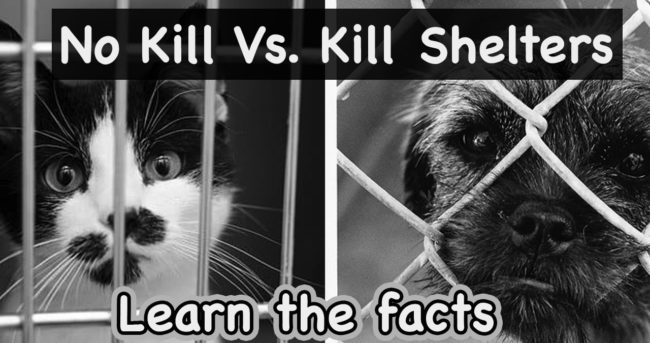Public shelters in the U.S. fall into two general categories: “kill” and “no-kill. Naturally, your first choice, if you had to surrender your pet, would be a no-kill shelter, but will they really protect your cat or dog? Let’s take a closer look at the facts and learn better alternatives for a pet you can no longer keep.
THE FACTS ABOUT NO-KILL SHELTERS:
- By Definition: A no-kill shelter is an animal shelter that does not kill healthy or treatable animals even when the shelter is full, reserving euthanasia for terminally ill animals or those considered dangerous to public safety.
- They can still euthanize 10% of the animals: Shelters can earn the status of being “no-kill” if they are able to save at least 90% of the animals they take in, so they can still euthanize up to 10%. In fact, one of our local no-kill shelters euthanized 349 animals last year. This is a matter of public record and you should research your local no-kill shelter if you decide on this route for your pet.
- Your pet could be turned away: Because of those quotas, and because space is a primary consideration, no-kill shelters will usually only accept animals that are considered “adoptable” and have a fairly good chance of finding a new home. All others, including most senior pets, cats or dogs in poor physical condition, injured ones with medical issues or behavioral problems, or even pets who lack “curb appeal” are turned away. These no-kill shelters often direct you to a kill facility.
- Kept in small cages for months: Cats and dogs in no-kill shelters can languish in small cages for months or even years. Numerous studies by PETA show that animals can start to deteriorate psychologically and physically after as little as two weeks in shelter cages.
- Can be euthanized due to sickness or behavioral problem: Pets in over-crowded shelters often develop physical ailments caused by stress or catch transmittable diseases from contact with other animals in the over-crowded facility. Once they begin to exhibit symptoms of a serious or transmittable illness or disease, the no-kill shelter will consider it “medically necessary” to euthanize them, even though the health problem is 100% the result of being in the shelter.
- Can be euthanized due to behavioral problems: Many previously gentle and well-behaved animals begin exhibiting behavioral problems caused by long periods of confinement in an over-crowded shelter, as outlined by Dr. Jeannine Berger, DVM. If a cat or dog starts showing dangerous signs of aggression, these pets can also be euthanized without jeopardizing the shelter’s no-kill designation.
- No guarantees of a good home: Because no-kill shelters are almost always over-populated and depend on quick adoptions to make room for more unwanted pets, animals are sometimes looked upon simply as inventory that must be moved, rather than as an individual who must be protected. These shelters simply don’t have the means or the screening safeguards in place to carefully check each prospective adopter and ensure that your pet is being adopted to a good home and not to an animal abuser, a hoarder, or someone with insufficient financial means to properly care for your pet.
- No-Kill shelters can transfer your pet to a Kill shelter or other facility: Yes, this happens and it happened to us! A No-Kill shelter can transfer your pet out for many reasons and by doing so, it helps keep their euthanization numbers low. They often transfer animals who have started to develop behavioral problems, an illness, or are too withdrawn or scared, to other facilities or kill shelters. We experienced this first-hand when a lady who adopted a cat named Ritz from our rescue decided to take the animal to a no-kill shelter, without informing us and in violation of her adoption agreement. The cat was soon transferred to a kill shelter. Fortunately, the kill shelter discovered that the cat had a “built-in-advocate” with his microchip being registered to our rescue. We believe he was transferred due to an infection in his eye that he developed at the No-Kill facility and are unsure if he would have been placed for adoption or euthanized if left there. He did ultimately find an amazing home.
- Your pet takes up a spot for another in need: Every animal at a no-kill shelter is occupying a space that keeps another animal from being taken in for lack of room. This means other pets will be turned away and either sent to kill shelters, given away to potentially unsuitable new owners or simply abandoned.
THE FACTS ABOUT KILL SHELTERS (Open-Admissions):
- By Definition: Kill shelters, or “open admissions” shelters, accept all abandoned, lost, confiscated or surrendered animals, regardless of “adoptability”, health, age, or behavioral issues.
- High euthanization rate: Depending on available space, animals that are considered “non-adoptable” due to illness, injury, poor health or age, are euthanized upon arrival. Even shy or skittish cats may be deemed “un-adoptable” and euthanized.
- 50 animals can be surrendered in a day: “Open admission” or kill shelters often receive an average of 50 animals a day. Sadly, the number of animals euthanized daily at these shelters is also estimated at 50 a day. It’s basically a “one in/one out” operation. For every animal that is taken in, another must be euthanized in order to make room.
- Stray animals can be euthanized within 72 hours: Strays are held for specified periods of time to see if their owners come to reclaim them, and then offered for adoption, if the shelter considers them a good candidate. If not, they are often euthanized within 72 hours.
BETTER ALTERNATIVES TO SURRENDERING YOUR PET TO A SHELTER
You picked your pet. Your pet did not choose you. They either win the lottery or they don’t. If for some reason, you can no longer keep your pet, you can at least give him or her the chance to find a great home without the risk of being euthanized at an over-crowded shelter. Could you imagine the stress and fear your pet goes through going from a safe and happy home to a metal cage surrounded by unfamiliar pets and people? We hope you can choose better alternatives by reading below.
- Look for a temporary foster: If you don’t have much time to place your unwanted pet, ask your friends, co-workers, family members, or various social media outlets including neighborhood apps, to house your unwanted pet temporarily until permanent placement can be found. If it is a cat, a bathroom could be used. This way your cat won’t interfere with anyone else’s “resident” pets. This will give much more time for permanent placement.
- Contact Furry Nation Salvation to start their FREE rehoming assistance program. With 10 years of experience, fast communication, and passion-driven motivation, we know where to place your pet to maximize exposure and use 5 pet approved adoption sites to do so. This program was designed to keep your pet happy and healthy in the comfort of their own home (or foster home) until permanent placement can be found. To learn more about this program click here.
- Contact breed-specific or foster-based rescue groups: Just because you’ve started Furry Nation Salvation’s rehoming assistance program, doesn’t mean you can’t keep actively looking for proper placement for your pet. Don’t close one door before another opens! SPREAD THE WORD! Contact as many rescues, animal-related group pages on Facebook, and people for help.
Pro Tips:
- Increase your pet’s adoptability by having it spayed or neutered! Contact your local shelter for locations of discount spay and neuter or click here for Furry Nation Salvation list of locations.
- Never abandoned your pet on the streets. They can die of starvation or get hit by a vehicle. It is much safer to bring your pet to an open admissions shelter than to abandon it.
- Please be patient. It can take several weeks to a few months to find your pet permanent placement. Furry Nation Salvation has tips and tricks to help you create a great ad that can help greatly with rehoming your pet.
In Summary: Surrendering your pet to a shelter, even a designated “no-kill” facility, is no guarantee that your pet will find another loving home. Of course, there are cases with happy endings, but many more animals end up languishing for months in a cage, adopted to unsuitable homes, or even euthanized. There are better alternatives to finding your pet a great home you can be proud of. Please consider them. Your pet depends on you.

